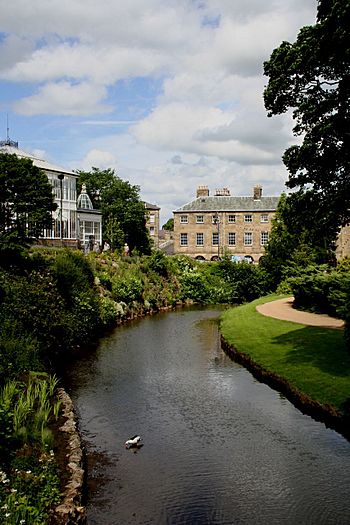River Wye, Derbyshire facts for kids
Quick facts for kids River Wye |
|
|---|---|

River Wye in Buxton
|
|
|
Confluence with Derwent in Derbyshire
|
|
| Country | England |
| Counties | Derbyshire |
| Physical characteristics | |
| Main source | Axe Edge Moor, Derbyshire |
| River mouth | Confluence with the Derwent Rowsley, Derbyshire 53°11′08″N 01°36′46″W / 53.18556°N 1.61278°W |
| Length | 24 km (15 mi) |
| Basin features | |
| Basin size | 277 km2 (107 sq mi) |
| Tributaries |
|
| Progression : Wye—Derwent—Trent—Humber—North Sea | |
- For other rivers named "Wye", see River Wye (disambiguation)
The River Wye is a beautiful river in Derbyshire, England. It flows through the stunning Peak District National Park. This river is about 22 miles (35 kilometers) long. It is a very important part of the River Derwent system. The Derwent then flows into the River Trent, which eventually reaches the River Humber and the North Sea.
Contents
The River Wye's Journey
The River Wye starts its journey just west of Buxton. Its source is on a moor called Axe Edge Moor. Some of the river's water flows underground through Poole's Cavern. It then comes back to the surface at a place called Wye Head.
Flowing Through Towns
From Wye Head, the river flows through the Pavilion Gardens in Buxton. It then travels east through the lovely dales of the Wye Valley. The main A6 road follows its path for much of this section.
The Wye enters the Peak District and flows just south of Tideswell. It continues through the villages of Ashford in the Water and Bakewell. Finally, it passes south of Haddon Hall before joining the River Derwent at Rowsley.
River Tributaries
The main river that flows into the Wye is the River Lathkill. The Lathkill joins the River Wye about one mile before the Wye meets the River Derwent.
Amazing Wildlife of the Wye
The River Wye is one of Derbyshire's most famous rivers. It is very popular with people who like to fish. This is because the river has many wild fish. You can find brown trout, rainbow trout, and grayling here.
Why the Wye is Full of Life
The water in the Wye is special because it is alkaline. This means it has lots of nutrients. These nutrients help many insects, invertebrates (small creatures without backbones), and other wildlife to grow. This provides plenty of food for the fish. Trout and grayling grow big and strong by eating things like freshwater shrimp, sedge, and different kinds of flies.
Water Voles Along the River
The River Wye is also home to many water voles. These small, furry animals are a type of rodent. The Wye has some of the largest groups of water voles in all of Britain. They love to live along the riverbanks.
Exploring the River Wye
You can walk alongside most of the River Wye. Many parts of the walking path follow an old railway line. Part of this old railway is now called the Monsal Trail. This trail gives you amazing views of the river as you walk.
The Monsal Viaduct
In a place called Monsal Dale, the old railway line comes out of a tunnel. It then crosses a huge bridge called a viaduct. This viaduct stands high above the river below. When it was built, not everyone was happy. A famous writer named John Ruskin was very upset. He felt that building the railway would spoil the beautiful natural area. He thought it was silly to build something just to get people from Buxton to Bakewell faster. Even though he didn't like it, the railway is now closed. The viaduct itself is now a special listed structure, meaning it is protected for its history.


